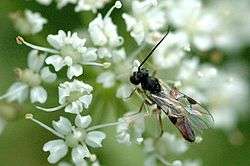Microgastrinae
| Microgastrinae | |
|---|---|
 | |
| Cotesia melanoscela | |
| Scientific classification | |
| Kingdom: | Animalia |
| Phylum: | Arthropoda |
| Class: | Insecta |
| Order: | Hymenoptera |
| Family: | Braconidae |
| Subfamily: | Microgastrinae |
Microgastrinae is a subfamily of braconid wasps,[1] encompassing 2,000 described species, with an estimated 5,000-10,000 total species.[2][3] This makes it one of the most specious subfamilies of parasitoid wasps.[4]
Genera
Genera within this subfamily include: [5]
- Alphomelon
- Apanteles
- Choeras
- Cotesia
- Dasylagon
- Deuterixys
- Diolcogaster
- Distatrix
- Dodogaster[6]
- Dolichogenidea
- Exoryza
- Fornicia
- Glyptapanteles
- Hypomicrogaster
- Microgaster
- Microplitis
- Miropotes
- Nyereria
- Parapanteles
- Paroplitis
- Pholetesor
- Prasmodon
- Promicrogaster
- Protomicroplitis
- Pseudapanteles
- Rhygoplitis
- Sathon
- Sendaphne
- Shireplitis
- Snellenius
- Venanides
- Venanus
- Wilkinsonellus
- Xanthomicrogaster
Description and distribution
These wasps are quite small, with long antennae and a dark marking on the wings. Species within this subfamily has an almost worldwide distribution. A known 135 species of Microgastrinae have been traced to Canada,[7][8] though the number may be as high as 275.[9] At least 28 species have been traced to Turkey in Gökçeada and Bozcaada.[10]
Biology
Microgastrinae wasps are primary gregarious braconid parasitoids on other insects, especially upon the larval stages of Lepidoptera. They usually lay more eggs on / in the same caterpillar. When the eggs hatch the young wasp larvae feed on blood, hemolymph and organs of their host. Later the larvae leave the caterpillar and immediately they make their cocoons, that stay attached to the remains of their host or to the vegetation without falling, even after the wasps emerge.
_cat_W_IMG_2862.jpg) Cocoons of Apanteles wasp and Papilio demoleus caterpillar
Cocoons of Apanteles wasp and Papilio demoleus caterpillar- Microgastrinae wasp empty cocoons
External Links & Media
![]() Media related to Microgastrinae at Wikimedia Commons
Media related to Microgastrinae at Wikimedia Commons
![]() Data related to Microgastrinae at Wikispecies
Data related to Microgastrinae at Wikispecies
References
- ↑ "UniProt Consortium Taxonomy Browser". Retrieved 2008-12-14.
- ↑ Mason, W. R. M. (1981). "The Polyphyletic Nature Of Apanteles foerster (Hymenoptera: Braconidae): A Phylogeny and Reclassification of Microgastrinae". Memoirs of the Entomological Society of Canada. 113 (115): 1. doi:10.4039/entm113115fv.
- ↑ Whitfield, James B. (1995). "Annotated Checklist of the Microgastrinae of North America North of Mexico (Hymenoptera: Braconidae)". Journal of the Kansas Entomological Society. 68 (3): 245–62. JSTOR 25085593.
- ↑ Fernandez, Jose L. (Fall 2007). "An overview and update of the Microgastrinae (Hymenoptera: Braconidae) holdings in the Canadian National Collection, Ottawa". Newsletter of the Biological Survey of Canada (Terrestrial Arthropods). Jose L. Fernandez Department of Integrative Biology, University of Guelph, Ontario, Canada. 26 (2).
- ↑ Encyclopedia of life
- ↑ Rousse, Pascal; Gupta, Ankita (2013). "Microgastrinae (Hymenoptera: Braconidae) of Reunion Island: A catalogue of the local species, including 18 new taxa and a key to species". Zootaxa. 3616 (6). doi:10.11646/zootaxa.3616.6.1.
- ↑ Marsh, P. "Catalog of Hymenoptera in America North of Mexico". Smithsonian Institution Press, Washington: 144–313.
- ↑ Yu, D.; van Achterberg, K.; Horstmann, K (2005). World Ichneumonoidea 2004. Taxonomy, Biology, Morphology and Distribution. CD/DVD. Taxapad, Vancouver.
- ↑ "Canada's Insect Fauna. Hymenoptera, Braconidae". Biological Survey of Canada. 2007. Archived from the original on 2008-06-29. Retrieved 2008-12-14.
- ↑ İnanç, Filiz; Beyarslan, Ahmet (2000). "A Study on Microgastrinae (Hymenoptera: Braconidae) Species in Gökçeada and Bozcaada". Turkish Journal of Zoology. 25 (3): 287–96.